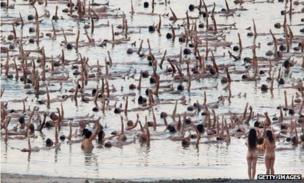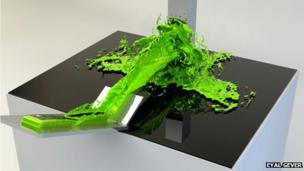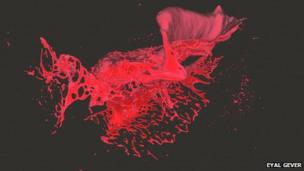 "A major new exhibition looks at technology's effect on the creative arts "  |
| An interactive exhibit that allows visitors to wave their arms and see how Inception's physics-defying spacial effects were created. |
 |
| Pyramidi is the work of Japanese designer Yuri Suzuki and will.i.am. It features a trio of robotic instruments and the exhibit is accompied by a visualiztion of will.i.am that appears to follow you around the room. |
London's Barbican Centre will host the Digital Revolution this summer which is a new exhibition that is designed to explore the impact of technology on art over the past forty years. The exhibition begins with a gallery called "Digital Archaeology" which highlights the key moments in the UK technological awakening, featuring rows of ancient machines such as the Magnavox Odyssey, the Speak & Spell, an original Pongcabinet, and a Linn LM-1 Drum Machine. This exhibit is then followed by a section focusing on the changes in film making as a result of technological advance in computing with looks at Inception, Gravity, and How To Train Your Dragon 2.
 |
| The Treachery of Sanctuary by Chris Milk uses Kinect cameras and 3D graphics to form modern takes on shadow play. His exhibit is broken into three sections exploring birth, death and transfiguration. |
The next showcase features a number of works from contemporary artsist and entertainers culminating in a spectacular interactive laser exhibit from Umbrellium. Included in the exhibit is a new collaboration between Japanese designer Yuri Suzuki and will.i.am, four interactive pieces from Google's DevArt project, and a small area showing indie games.
"The show is really artist-led, but also looks at technology, and the technology stories that are very important to the show as it progresses," curator Conrad Bodman tells The Verge."It's the first show of its kind in the UK that explores the idea of digital creativity quite holistically."
 |
| The "Petting Zoo" entices visitors to play with playful robotic arms. |
 |
| Umbrellium's exhibit is set in a pitch black room and uses lasers to turn the entire floor into a canvas. Visitors can "grab" a laser and draw their own artwork on the floor. |
Source: http://www.theverge.com/2014/7/3/5867225/digital-revolution-barbican-london-exhibition-photo-essay











































